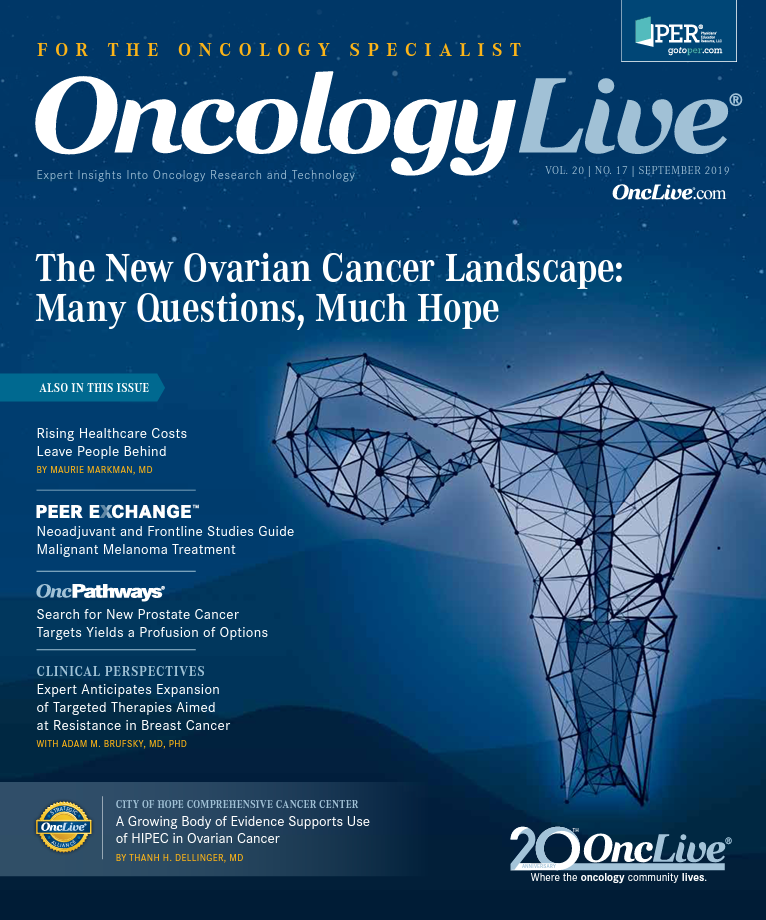Publication
Article
Oncology Live®
New Strategies Are Evolving for Breast Cancer Brain Metastases
Author(s):
A greater focus on studying mechanisms for therapies that penetrate the blood–tumor barrier and the expansion of clinical trial eligibility criteria are opening the door for advancements that may help patients with metastatic breast cancer that has spread to the brain, according to Carey K. Anders, MD.
Carey Anders, MD, associate professor, Department of Medicine, Division of Hematology and Oncology, UNC-Chapel Hill.

Carey Anders, MD
A greater focus on studying mechanisms for therapies that penetrate the blood—tumor barrier and the expansion of clinical trial eligibility criteria are opening the door for advancements that may help patients with metastatic breast cancer that has spread to the brain, according to Carey K. Anders, MD.
Historically, the clinical development of treatments in this setting has been hampered because of the challenges presented by the blood—brain barrier, but preclinical literature suggests a greater emphasis on the blood–tumor barrier in the metastatic setting, Anders said.1 Additionally, exclusion criteria that accompany clinical trial enrollment have relaxed somewhat, “with a shift in the tide that now includes patients with CNS [central nervous system] disease,” Anders told attendees during the 18th Annual International Congress on the Future of Breast Cancer® East hosted by Physicians’ Education Resource®, LLC, July 19-20 in New York, New York.2
These changes, coupled with a deeper understanding of the biology of brain metastases, represent encouraging developments to oncologists as they counsel their patients with metastatic breast cancer that has spread to the brain. Anders, medical director of the Brain and Spine Metastases Program at Duke Cancer Center in Durham, North Carolina, also discussed local therapy techniques that recognize the importance of neurocognition and advances in systemic therapies that focus on improvement in both intra- and extracranial disease.
In the past, brain cancer metastases were a standard clinical trial exclusion criterion. That has changed with randomized clinical trials being designed specifically for patients with stable and progressive disease, including treatment-naïve patients with brain metastases.
The American Society of Clinical Oncology (ASCO) and Friends of Cancer Research have issued a joint research statement that broadens eligibility criteria affecting 2 patient subgroups: patients with treated/stable brain metastases and those with new, active, or progressive brain metastases.3
Similarly, clinical trials sponsored by the National Cancer Institute (NCI) now allow patients with stable brain metastases to enroll if no evidence of progression is confirmed by follow-up imaging after they have received CNS-directed therapy. Patients with active brain metastases or leptomeningeal disease may enroll if the treating physician determines that CNS-specific treatment is not required and is unlikely to be needed during the first cycle of therapy.
“These are welcome inclusion criteria to researchers and patients,” Anders said. Clinical trials involving immune checkpoint inhibitors have also encouraged enrollment of patients with brain metastases but only in melanoma and lung cancer, noted Anders.4
Local Therapy Updates
In general, Anders has noted a trend away from the use of whole brain radiation therapy (WBRT), with radiation oncologists opting for stereotactic radiosurgery (SRS). A role exists for WBRT in patients with multiple lesions, but the maximum number of lesions for optimal WBRT remains debatable.
One study led by Masaaki Yamamoto, MD, demonstrated that SRS administered to patients with 5 to 10 lesions was not inferior to SRS given to patients with 2 to 4 lesions in a cohort of 1194 patients who had 1 to 10 brain metastases.5 Patients with tumor volumes smaller than 4 mL were irradiated with 22 Gy at the lesion periphery, and those with volumes of 4 to 10 mL were given 20 Gy. The findings suggest that SRS might be a suitable alternative for patients with up to 10 brain metastases. Anders pointed out, however, that the study was not a head-tohead comparison of SRS and WBRT.
The detrimental neurocognitive effects of WBRT are also a factor to consider. In RTOG 0614,6 508 patients with brain metastases were randomized to receive WBRT of 37.5 Gy in 15 fractions plus memantine at 20 mg daily or WBRT of 37.5 Gy in 15 fractions plus placebo. Although the trial did not meet its P value, there was a relative risk of 17% in cognitive decline at 24 weeks versus placebo, Anders said. The investigators reported no difference in progression-free survival (PFS) or overall survival. Another phase III trial comparing memantine and WBRT with or without hippocampal avoidance in reducing neurocognitive decline is currently ongoing, said Anders.7
Anders also discussed the deteriorating cognitive effects of SRS combined with WBRT. “Brown P et al showed that we should not be following SRS with WBRT in the modern era,” she said. In a phase III trial, patients with 1 to 3 brain metastases were randomized to receive SRS or SRS plus WBRT between February 2002 and December 2013 in 34 institutions across North America. The primary endpoint of cognitive deterioration at 3 months was less frequent with SRS alone compared with SRS plus WBRT (63.5% vs 91.7%, P < .001). Although the investigators reported that survival was almost the same between the 2 cohorts, the rate of cognitive deterioration was different. Deterioration was much less frequent in the SRS-alone group at 63% compared with over 90% in patients who received WBRT.8 “Preservation of neurocognitive capacity is important to patients, and it impacts their quality of life,” she said.
Systemic Therapy Options
Systemic therapy for HER2-positive breast cancer metastases includes the commercially available agents lapatinib (Tykerb), T-DM1 (ado-trastuzumab emtansine; Kadcyla), neratinib (Nerlynx), anthracyclines, and platinum salts (Table). Anders pointed out that neratinib is indicated for high-risk early breast cancer only. The 2018 National Comprehensive Cancer Network Guidelines on Neuro-Oncology include neratinib as an option for patients with HER2-positive breast cancer brain metastases.9
In the setting of progressive lesions post radiation therapy, Lin et al10 reported a CNS objective response rate (ORR) of 2.6% (RECIST 1.1) and 5.2% (50% volumetric reduction) for lapatinib. These findings led to a larger study that combined lapatinib with capecitabine. In the lapatinib-only arm, a 6% CNS ORR was reported, but in the lapatinib plus capecitabine arm, a 20% CNS ORR was reported.11
Neratinib, part of a new group of compounds that bind irreversibly to the adenosine triphosphate binding pocket of HER receptors, has been developed. This irreversible tyrosine kinase inhibitor binds and inhibits tyrosine kinase activity of epidermal growth factor receptor, leading to reduced phosphorylation and activation of downstream signaling pathways.
In TBCRC 022, Freedman et al demonstrated a CNS ORR of 49% in patients who received neratinib plus capecitabine.12 Notable gastrointestinal (GI) adverse events associated with neratinib/capecitabine can be managed with an antidiarrheal agent, Anders said.
The NALA study involving patients with HER2-positive metastatic breast cancer who had received 2 prior lines that compared neratinib versus lapatinib were announced at the 2019 ASCO Annual Meeting.13 Investigators reported that combining neratinib with capecitabine led to a 24% reduction in the risk of disease progression or death compared with lapatinib plus capecitabine.
Emerging Research
Select ongoing clinical trials include T-DM1 plus temozolomide (NCT03190967), HER2CLIMB (NCT02614794), neratinib plus T-DM1 (NCT02236000), and high-dose trastuzumab (close to accrual, awaiting mature data; NCT02614794).
NCT03190967 is an NCI phase I/II study involving T-DM1 alone versus T-DM1 plus temozolomide as a secondary prevention of HER2-positive breast cancer brain metastases following SRS. “The goal of the study is to show that temozolomide decreases distant brain metastases and provides protection for the nonirradiated area of the brain,” Anders said.
Another tyrosine kinase inhibitor, tucatinib, is highly selective for HER2. As a result, “we don’t expect to see the GI toxicities and the rash associated with dual HER1 and HER2 inhibitors,” Anders said. In a phase I study of capecitabine plus trastuzumab (Herceptin) with tucatinib, CNS ORR has been reported at 42%. This early trial has led to the HER2CLIMB phase III study in patients with advanced HER2 metastatic breast cancer, in which 600 patients will be randomized 2:1 to receive trastuzumab and capecitabine plus either tucatinib or placebo. The primary endpoint is PFS by RECIST 1.1. The trial has completed accrual, and investigators are analyzing results.
Immunotherapy trials are also being explored in brain metastases , said Anders. She noted the research of Priscilla Kaliopi Brastianos, MD, at Massachusetts General Hospital in Boston, which is a phase II basket trial involving cohorts in solid tumor brain metastases, leptomeningeal disease, and concurrent SRS.
“This is an area that is finally gaining momentum. We have some options [available to us] in clinic with ongoing research developments every day,” concluded Anders.
References
- Groothius DR. The blood-brain and blood-tumor barriers: A review of strategies for increasing drug delivery. Neuro Oncol. 2000;2(1):45-59. doi: 10.1093/neuonc/2.1.45.
- Anders CK. Management of brain metastases. Presented at: 18th Annual International Congress on the Future of Breast Cancer® East; July 19-20, 2019; New York, NY.
- Kim ES, Bruinooge SS, Roberts S, et al. Broadening eligibility criteria to make clinical trials more representative: American Society of Clinical Oncology and Friends of Cancer Research joint research statement. J Clin Oncol. 2017;35(33):3737-3744. doi: 10.1200/JCO.2017.73.7916.
- Goldberg SB, Gettinger SN, Mahajan A, et al. Pembrolizumab for patients with melanoma or non-small-cell lung cancer and untreated brain metastases: early analysis of a non-randomised, open-label, phase 2 trial. Lancet Oncol. 2016;17(7):976-983. doi: 10.1016/S1470-2045(16)30053-5.
- Yamamoto M, Serizawa T2, Shuto T, et al. Stereotactic radiosurgery for patients with multiple brain metastases (JLGK0901): a multi-institutional prospective observational study. Lancet Oncol. 2014;15(4):387-395. doi: 10.1016/S1470-2045(14)70061-0.
- Brown PD, Pugh S, Laack NN, et al; Radiation Therapy Oncology Group (RTOG). Memantine for the prevention of cognitive dysfunction in patients receiving whole-brain radiotherapy: a randomized, double-blind, placebo-controlled trial. Neuro Oncol. 2013;15(10):1429-1437. doi: 10.1093/neuonc/not114.
- Memantine Hydrochloride and Whole-Brain Radiotherapy With or Without Hippocampal Avoidance in Reducing Neurocognitive Decline in Patients with Brain Metastases. clinicaltrials.gov/ct2/show/NCT02360215. Updated January 14, 2019. Accessed July 24, 2019.
- Brown PD, Jaeckle K, Ballman KV, et al. Effect of radiosurgery alone vs radiosurgery with whole brain radiation therapy on cognitive function in patients with 1 to 3 brain metastases: a randomized clinical trial. JAMA. 2016;316(4):401-409. doi: 10.1001/jama.2016.9839.
- National Comprehensive Cancer Network. Central Nervous System Cancers, version 1.2019. National Comprehensive Cancer Network website. nccn.org/professionals/physician_gls/pdf/cns.pdf. Published March 5, 2019. Accessed July 30, 2019.
- Lin NU, Carey LA, Liu MC, et al. Phase II trial of lapatinib for brain metastases in patients with human epidermal growth factor receptor 2-positive breast cancer. J Clin Oncol. 2008;26(12):1993-1999. doi: 10.1200/JCO.2007.12.3588.
- Lin NU, Diéras V, Paul D, et al. Multicenter phase II study of lapatinib in patients with brain metastases from HER2-positive breast cancer. Clin Cancer Res. 2009;15(4):1452-1459. doi: 10.1158/1078-0432.CCR-08-1080.
- Freedman RA, Gelman RS, Anders CK, et al; Translational Breast Cancer Research Consortium. TBCRC 022: a phase II trial of neratinib and capecitabine for patients with human epidermal growth factor receptor 2-positive breast cancer and brain metastases. J Clin Oncol. 2019;37(13):1081-1089. doi: 10.1200/JCO.18.01511.
- Saura C, Oliveira M, Feng Y-H, et al. Neratinib + capecitabine versus lapatinib + capecitabine in patients with HER2+ metastatic breast cancer previously treated with ≥ 2 HER2-directed regimens: Findings from the multinational, randomized, phase III NALA trial. J Clin Oncol. 2019;37(suppl 15; abstr 1002). doi: 10.1200/JCO.2019.37.15_suppl.1002.



























%20(2)%201-Recovered-Recovered-Recovered-Recovered-Recovered-Recovered-Recovered-Recovered-Recovered-Recovered-Recovered-Recovered-Recovered-Recovered-Recovered-Recovered-Recovered.jpg?fit=crop&auto=format)
%20(2)%201-Recovered-Recovered-Recovered-Recovered-Recovered-Recovered-Recovered-Recovered-Recovered-Recovered-Recovered-Recovered-Recovered-Recovered-Recovered-Recovered-Recovered.jpg?fit=crop&auto=format)
